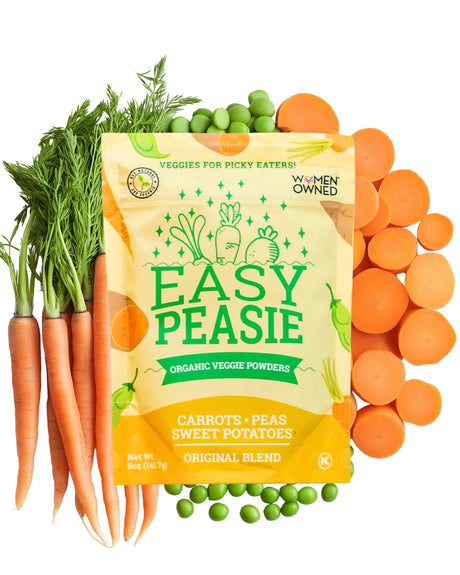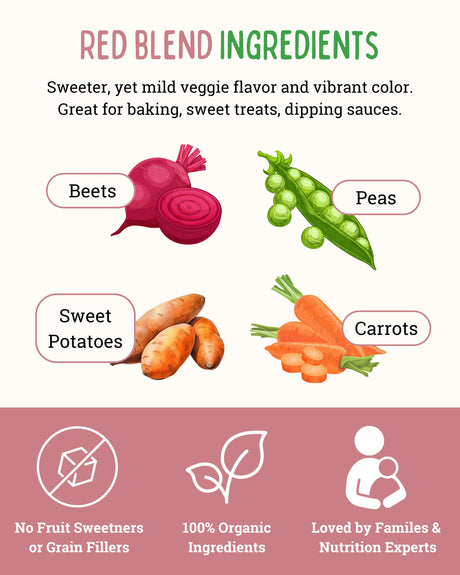Embracing Fiber for Your Child's Digestive Harmony
The Foundation of Well-being: Gut Health
Gut health is the cornerstone of our overall well-being, a truth that holds especially true for our little ones. It's the engine room where nutrients are absorbed, waste is processed, and a significant part of their immune system resides.
Ensuring this core system functions smoothly is pivotal to a child's vitality and health.
Fiber: The Unsung Hero of Digestion
Enter dietary fiber, the unsung hero often overshadowed by more glamorous nutrients. Yet, its role is no less critical. Fiber keeps the digestive tract flowing, aids in nutrient absorption, and even plays a part in satiety.
It's a key player, not just in maintaining regularity, but in sculpting a robust digestive system for kids.
Zooming In: Kids' Digestive Systems
Children's digestive systems are still developing, making them more sensitive and reactive to dietary changes. This article zooms in on the specific needs of these growing bodies, shedding light on how fiber can support and enhance young digestive tracts, setting the stage for a lifetime of health.
What is Fiber? Understanding the Basics

Defining Dietary Fiber
Dietary fiber, often referred to as nature's broom, is a plant-based nutrient that is essential for a healthy digestive system. Unlike other food components such as fats, proteins, or carbohydrates — which your body breaks down and absorbs — fiber isn't digested by your body.
Instead, it passes relatively intact through your stomach, small intestine, and colon and out of your body.
Soluble vs. Insoluble: The Fiber Duo
Fiber comes in two varieties, both beneficial for health. Soluble fiber dissolves in water to form a gel-like substance. Found in oats, peas, beans, apples, citrus fruits, carrots, barley, and psyllium, it can help lower blood cholesterol and glucose levels.
Insoluble fiber, found in foods like whole-wheat flour, wheat bran, nuts, beans, and vegetables such as cauliflower, green beans, and potatoes, helps add bulk to the stool and appears to help food pass more quickly through the stomach and intestines.
Fiber at Work: The Body's Natural Regulator
In the body, fiber functions as a regulator and a stabilizer. It slows the absorption of other nutrients, such as sugars, which can help with blood sugar control. It also provides bulk to the stool, which can prevent constipation.
By aiding in the movement of material through the digestive system, fiber helps to maintain bowel health and can lower the risk of developing diseases like diverticulitis.
The Importance of Fiber for Kids

Fiber: A Growth Catalyst
When it comes to children, fiber is more than just a digestive aid; it's a catalyst for healthy growth and development. As kids grow, their bodies demand a variety of nutrients to support the rapid changes they experience.
Fiber plays a crucial role in this developmental symphony, contributing to a well-functioning digestive system that ensures all other nutrients are properly absorbed.
Digestive Health: Laying the Foundation
A child's digestive health is the cornerstone of their overall well-being. Fiber contributes significantly to this area by helping to maintain regular bowel movements, which is essential for preventing constipation, a common issue in childhood.
Regular intake of fiber-rich foods keeps their digestive system moving and can prevent the discomfort associated with digestive disruptions.
A Long-term Health Ally
The benefits of fiber extend well beyond the immediate relief of the digestive tract. Adequate fiber intake in childhood is linked to long-term health benefits, such as reduced risks of developing chronic conditions like type 2 diabetes, heart disease, and certain forms of cancer. By instilling healthy eating habits that include plenty of fiber-rich foods, parents can set their children up for a healthier future.
Fiber's Digestive Benefits in Detail
Regularity and Constipation Prevention
One of the most celebrated roles of dietary fiber is its ability to promote regularity and prevent constipation. For many kids, constipation can be a common and uncomfortable problem. A diet rich in fiber increases the bulk and softness of the stool, making it easier to pass. This not only helps maintain a healthy digestive rhythm but also prevents the discomfort and potential complications associated with constipation.
Soluble Fiber: The Digestive Harmonizer
Soluble fiber, found in foods like oats, apples, and beans, has a unique role in digestion. It dissolves in water to form a gel-like substance, which helps to slow down digestion. This slowing effect allows for better absorption of nutrients and can help stabilize blood sugar levels by controlling the rate at which carbohydrates are absorbed.
For kids, this means sustained energy levels and a feeling of fullness that can aid in healthy weight management.
Insoluble Fiber: The Gut's Rhythm Keeper
Insoluble fiber, abundant in whole grains, nuts, and vegetables, acts as the gut's rhythm keeper. It adds bulk to the stool and helps food pass more quickly through the stomach and intestines, which is essential for gut health.
This type of fiber supports a healthy and diverse microbiome, as it provides the roughage that helps to keep the intestinal tract clean and efficient.
Recommended Fiber Intake for Children
Ages and Stages: Fiber Needs for Growing Bodies
The amount of fiber children need depends on their age and gender. Generally, a good rule of thumb is that children should consume "age plus five" grams of fiber per day. For instance, a 4-year-old would need about 9 grams of fiber each day.
As children grow, their fiber needs increase. Girls aged 9 to 18 should aim for 26 grams per day, while boys in the same age range need 31 to 38 grams daily. These guidelines ensure that as children's bodies develop, they're getting enough fiber to support their digestive health and overall well-being.
Finding the Fiber Balance
While fiber is essential, it's also important not to go overboard. Signs of inadequate fiber intake include irregular bowel movements, constipation, and for some kids, an increased feeling of hunger due to less satiety after meals.
On the flip side, too much fiber can lead to bloating, gas, and stomach cramps, particularly if fiber intake is increased too quickly or without enough fluid intake. It's all about finding that fiber balance to keep kids' digestive systems running smoothly.
Identifying High-Fiber Foods
Kid-Friendly Fiber Powerhouses
When it comes to boosting fiber intake for kids, think fun and flavorful! Fruits like raspberries, pears, and apples (with the skin on) are fiber-rich and kid-approved. Vegetables such as carrots, broccoli, and sweet peas can be both a colorful and nutritious addition to any meal.
Don't forget about legumes; black beans, lentils, and chickpeas are not only high in fiber but also versatile enough to sneak into a variety of dishes. Whole grains are another excellent source; look for whole wheat bread, oatmeal, and popcorn as snackable options that pack a fiber punch.
Making Fiber Fun and Tasty
Incorporating these foods into a child's diet doesn't have to be a chore. Get creative with smoothies by blending fruits with a handful of spinach for an extra fiber boost. Make a game out of trying new vegetables each week, and involve kids in the kitchen to prepare fiber-rich snacks like hummus with veggie sticks or homemade trail mix with nuts and dried fruits.
For a treat, bake fiber into muffins or make a batch of oatmeal cookies. By making fiber a fun and tasty part of meals and snacks, you'll help children develop a love for these nutritious foods early on.
Challenges in Meeting Fiber Needs

Picky Eaters: A Fiber Dilemma
It's no secret that many kids are selective about what they eat, often turning up their noses at fiber-rich fruits, vegetables, and grains. This can pose a significant challenge for parents trying to ensure a well-rounded diet. The key is patience and persistence.
Introduce new fiber-rich foods slowly and pair them with familiar favorites. Remember, it can take multiple exposures to a new food before a child accepts it.
Creative Solutions for Busy Families
In today's fast-paced world, convenience often trumps nutrition, leading to a shortfall in fiber intake. To combat this, planning is crucial. Prepare fiber-rich snacks ahead of time, like veggie sticks with dip or whole-grain crackers with cheese, so they're ready to grab and go.
Consider setting aside time on the weekend to batch-cook meals that incorporate plenty of vegetables, beans, and whole grains.
These can be quickly reheated on busy weeknights, ensuring that fiber remains on the menu even when time is short.
Incorporating Fiber in Every Meal
For breakfast, start with oatmeal topped with fruit or whole-grain toast with avocado. Lunchboxes can include sandwiches on whole-grain bread, along with cut-up veggies and a piece of fruit. Dinner might feature a stir-fry loaded with vegetables or a hearty bean soup. And for snacks, think outside the box: apple slices with peanut butter, a small handful of nuts, or air-popped popcorn can be both satisfying and fiber-filled.
Education and Involvement
Educate your kids about why fiber is essential, and get them involved in food selection and preparation. Children are more likely to eat what they've helped make, so let them toss the salad or assemble the veggie pizza. By understanding the importance of fiber and feeling empowered in their food choices, kids are more likely to embrace and enjoy fiber-rich foods.
Recipes and Meal Ideas
Simple Swaps for a Fiber Boost
Getting kids to eat more fiber doesn't have to mean a complete menu overhaul. Start with what they already like and make simple swaps. Use whole-grain pasta for spaghetti night, or try adding a scoop of beans to their favorite taco filling. These small changes can significantly increase the fiber content of their meals without a battle at the dinner table.
Fiber-Friendly Breakfasts
Begin the day on a high note with a fiber-rich breakfast. A smoothie bowl can be a fun and colorful way to start, blending fruits with a handful of spinach or kale—top with a sprinkle of chia seeds or a scoop of oatmeal for an extra fiber kick. Or, try whole-grain pancakes topped with a berry compote; the fruit provides fiber, and the whole grains keep them full until lunch.
Lunchbox Makeover
Lunchtime offers a great opportunity to sneak in more fiber. A turkey and cheese sandwich becomes a fiber powerhouse when you use whole-grain bread. Add a crunchy carrot and cucumber salad on the side, or swap out the chips for some air-popped popcorn. For a sweet treat, pack a small container of trail mix with nuts, seeds, and dried fruit.
Dinner that Delivers
For dinner, a one-pan roasted vegetable and quinoa dish can be a hit. Let the kids pick out which veggies to include to give them a sense of control and anticipation for the meal. Another option is a build-your-own burrito bowl night with brown rice, black beans, lots of fresh veggies, and guacamole. It's a fun way to let kids customize their meal while loading up on fiber.
Snack Time Solutions
When it comes to snacks, think beyond the processed foods aisle. Homemade granola bars packed with oats, nuts, and seeds can be a tasty and fiber-rich treat. Or, for something savory, baked kale chips or roasted chickpeas offer a crunchy alternative to potato chips. These snacks are not only full of fiber but also are fun for kids to help make.
Desserts with Benefits
Even dessert can be an opportunity to increase fiber intake. A batch of oatmeal cookies with added raisins or dates can satisfy a sweet tooth while providing fiber. Or, for a summer treat, homemade popsicles made from pureed fruit and a bit of yogurt can be both refreshing and fiber-friendly.
Involving Kids in Fiber-Friendly Eating
Nutrition Education Made Fun
Teaching kids about nutrition doesn't have to be a lecture. Turn it into a game! Create a colorful chart or a set of flashcards with different fiber-rich foods and have them match the food to its fiber content. This visual and interactive approach makes learning about fiber fun and memorable.
Fiber Food Art
Get creative with food presentations to make fiber-rich foods more appealing to kids. Encourage them to make art on their plates using a variety of fruits, vegetables, nuts, and seeds. They can create faces, animals, or scenes that will not only look great but taste great too. It's a playful way to get them excited about eating foods that are good for their digestion.
Grow Your Own Fiber
If you have space, start a small vegetable garden. Kids are more likely to try something they've grown themselves. Herbs, carrots, and tomatoes are all easy to grow and are great sources of fiber. Gardening is not just a way to get them outside and active, but it also teaches them where food comes from and the importance of dietary fiber.
Cooking Classes at Home
Host a cooking class in your kitchen. Pick out simple recipes that are rich in fiber and walk your kids through the cooking process. As they help prepare dishes like bean salads or whole-grain pasta, they'll learn cooking skills and the nutritional value of the ingredients they're using.
Fiber Detective
Turn grocery shopping into an educational experience by making your kids 'fiber detectives.' Give them a list of high-fiber foods and ask them to find them in the store. They can read labels to check the fiber content and help choose the best options. This not only makes them feel involved but also teaches them how to make healthy choices.
Snack Preparation
Encourage your kids to prepare their own snacks. Set up a 'snack station' in your kitchen with pre-portioned bags of nuts, seeds, dried fruits, and whole-grain crackers. Show them how to combine these items to make a satisfying, fiber-rich snack. This gives them the independence to choose their snacks while steering them towards healthier options.
Wrapping Up: The Fiber-Full Path to Healthy Growth

The Fiber Foundation in Digestive Health
As we wrap up our fiber-focused journey, let's revisit the critical role this nutrient plays in our children's digestive health. Fiber is more than just a dietary component; it's a foundational element that supports regularity, aids in digestion, and contributes to the overall well-being of our growing kids.
Empowering Parents to Take Charge
It's essential for parents to take an active role in managing their children's fiber intake. Assessing and improving dietary fiber can seem daunting, but it's a rewarding endeavor. By introducing a variety of fiber-rich foods into your child's diet, you're setting them up for a lifetime of health benefits.
A Community of Fiber-Friendly Families
I encourage you to join the conversation and share your fiber-enhancing tips and experiences. Have you found creative ways to weave more whole grains, fruits, and veggies into your child's meals? What challenges have you faced, and how have you overcome them? Your stories and advice are invaluable to this community of health-conscious parents.
Leave your comments below; we love to hear from you! And don't forget to follow EasyPeasie for more veggie info and convo on YouTube, Facebook, and Instagram! ~ThePeas













